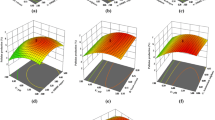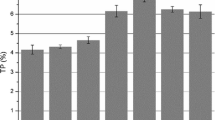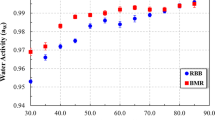Abstract
The present study demonstrates that the monacolin K concentration of Monascus-fermented rice can be increased by proper optimisation of fermentation parameters using a Box-Behnken experimental design. The monacolin K level was increased by up to 10% in a response surface method (RSM)-optimised medium composition as compared to a composition optimised using a classical method. The effect of nutritional factors such as substrate sources, carbon sources, nitrogen sources and inducers on monacolin K production was studied using Monascus purpureus MTCC 1090 in solid-state fermentation using Indian rice as the substrate. Other fermentation parameters like pH, temperature and particle size of substrate were also optimised using the ‘one-factorat-a-time’ classical method. The concentrations of most significant factors and their interactions were studied using RSM. The optimal medium components for enhanced monacolin K production were found to be fructose, 2.14% (w/w); sodium nitrate, 0.16% (w/w); acetic acid, 0.60% (v/w) at pH 5, temperature 30°C and particle size of selected substrate (IR-532-E-576 rice) 2 mm. A maximum monacolin K fortification of up to 37.002 μg/ml was obtained under the optimised conditions.
Similar content being viewed by others
References
Lin YL, Wang TH, Lee HH, Su NW (2008) Biologically active components and nutraceuticals in the Monascus-fermented rice: a review. Appl Microbiol Biotechnol 77:965–973
Steinkraus KH (1983) Handbook of indigenous fermented foods. Dekker, New York
Su YC, Chen WL, Fang HY, Wong HC, Wang WH (1970) Mycological study of Monascus anka (in Chinese). J Chin Agr Chem Soc 8:46–54
Rajasekaran A, Kalaivani M (2011) Hypolipidemic and antioxidant activity of aqueous extract of Monascus purpureus fermented Indian rice in high cholesterol diet fed rats. Turk J Med Sci 41:25–32
Rajasekaran A, Kalaivani M, Sabitha R (2009) Anti-diabetic activity of aqueous extract of Monascus purpureus fermented rice in high cholesterol diet-fed streptozotocin-induced diabetic rats. Asian J Sci Res 2:180–189
Ricky WK, Bakr R (2008) Chinese red yeast rice (Monascus purpureus fermented rice) promotes bone formation. Chin Med 3:4
Ho BY, Wu YM, Hsu YW, Hsu LC, Kuo YH, Chang KJ, Pan TM (2010) Effects of Monascus-fermented rice extract on malignant cell associated neovascularization and intravasation determined using the chicken embryo chorioallantoic membrane model. Integr Cancer Ther. doi:10.1177/1534735410365079
Kalaivani M, Sabitha R, Kalaiselvan V, Rajasekaran A (2010) Health benefits and clinical impact of major nutrient, red yeast rice: a review. Food Bioprocess Technol 3:333–339
Box GEP, Behnken DW (1960) Three level design for the study of quantitative variables. Technometrics 2:455–475
Gopinath SCB, Hilda A, Lakshmi Priya T, Annadurai G, Anbu P (2003) Statistical optimization of amylase production by Aspergillus versicolor. Asian J Microbiol Biotechnol Environ Sci 5:327–330
Wang JJ, Pan TM (2003) Effect of red mold rice supplements on serum and egg yolk cholesterol levels of laying hens. J Agric Food Chem 51:4824–4829
Skowronek M, Fiedurek J (2004) Optimisation of inulinase production by A. niger. Food Technol Biotechnol 42:141–146
Wang YS, Xu JM, Zheng RC, Zheng YG, Shen YC (2008) Improvement of amidase production by a newly isolated Delftia tsuruhatensis ZJB-05174 through optimization of culture medium. J Microbiol Biotechnol 18:1932–1937
Li YG, Liu H, Wang ZT (2005) A validated stability-indicating HPLC with photodiode array detector (PDA) method for the stress tests of Monascus purpureus-fermented rice, red yeast rice. J Pharm Biomed Anal 39:82–90
Stanbury PE, Whitaker A, Hall SJ (1997) Principles of fermentation technology. Aditya, New Delhi, India
Soni P, Singh M, Kamble AL, Ban UC (2007) Response surface optimization of the critical medium components for carbonyl reductase production by Candida viswanathii MTCC 5158. Bioresource Technol 98:829–833
Bankar SB, Bule MV, Singhal RS, Ananthanarayan L (2009) Optimization of Aspergillus niger fermentation for the production of glucose oxidase. Food Bioprocess Technol 2:344–352
Yugandhar NM, Ravi Kumar DVR, Prasanthi V, Kiran Kumar N, Sri Rami Reddy D (2008) Optimization of pectinase production from Manihot utilissima by Aspergillus niger NCIM 548 using statistical experimental design. Res J Microbiol 3:9–16
Author information
Authors and Affiliations
Corresponding author
Rights and permissions
About this article
Cite this article
Rajasekaran, A., Kalaivani, M. Biofortification of Indian rice (IR-532-E-576) with monacolin K by RSM optimisation using Monascus purpureus MTCC 1090. Nutrafoods 11, 49–54 (2012). https://doi.org/10.1007/s13749-012-0031-1
Received:
Accepted:
Published:
Issue Date:
DOI: https://doi.org/10.1007/s13749-012-0031-1




